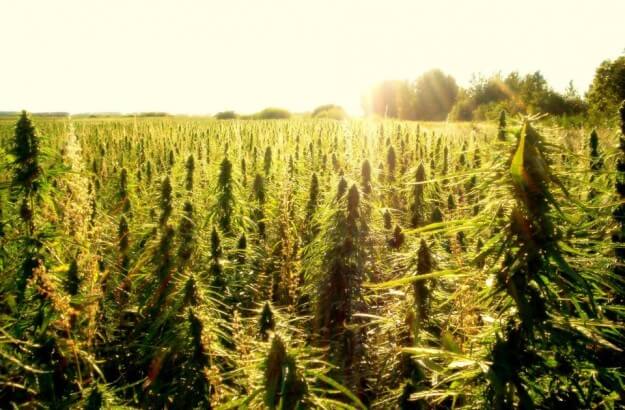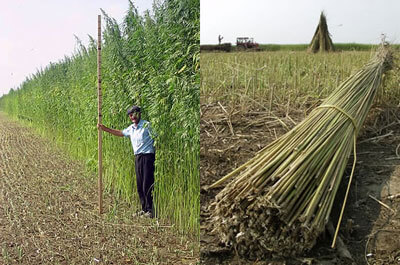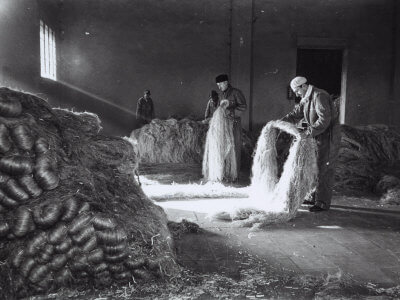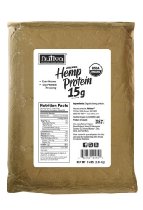People are starting to realize that hemp cars are going to be a wave of the future. It may be hard to imagine a car manufactured from grass, as it may seem to lack the sturdy component needed for a functional car. However, scientists claim that cars made from plants are actually an upcoming trend. Researchers in England and Australia are working towards developing materials made from plants such as elephant grass and hemp that are to replace different car components made from metal and plastic. According to these scientists, the plant-based car materials are not only biodegradable, but can also enhance fuel efficiency, as they weigh nearly 30% less than the materials that are currently used in making car components. A lighter car generally needs less fuel to drive it.
Industrial hemp for car construction
Building car components including the outer shell using hemp could lower the ever increasing number of rusting car body parts from old lots. Hemp fibers are thoroughly cleaned then heated and sometimes blended with a few biodegradable plastic to increase their overall strength. They are then molded to form hardened filling and paneling. Hemp is also considered to be significantly cheaper to produce when compared to the manufacture of other materials such as steel.
Henry Ford’s Hemp Car
In the 1910s, Henry Ford tried experimenting with using agricultural products in the manufacture of his automobiles. In 1941, he came up with a solution and built a car that contained cellulose fibers derived from hemp, sisal, and wheat straw. The plastic was said to be lighter than steel and 10 times stronger than steel! Watch the video as Ford demonstrated its strength by attacking it with an axe.
Later that same year, the plastic car had been scrapped. The reason for this is not entirely certain, but sources say that it was because car manufacturing had stopped during WWII, and all energy was diverted to war recovery efforts.
Kerstel Car

Kerstel Car by Motive
Kestrel is expected to be warmer, quieter, and without any smell. According to Armstrong, the vibrations produced by natural fibers are quite pleasant. He also deems the car safer in the event of a crash, since it springs or bounces back rather than squishing or crumbling. However, Motive cannot confidently state the wear and tear effects of the car in the long run because of the novelty of the car’s technology. Nonetheless, their aim is to create a durable car that is also easy to repair.
Eco Elise, Lotus Hemp Car
 Yup, we saved the best one for last. In 2008, Lotus announced its eco-friendly car made out of hemp. The Eco Elise weighs 32 kg (70.5 lbs) less than the standard Elise S, which means it will give higher fuel economy figures and better performance. The green materials used for the car have been carefully studied to ensure that each technology used reduces the environmental impact of the vehicle.
Yup, we saved the best one for last. In 2008, Lotus announced its eco-friendly car made out of hemp. The Eco Elise weighs 32 kg (70.5 lbs) less than the standard Elise S, which means it will give higher fuel economy figures and better performance. The green materials used for the car have been carefully studied to ensure that each technology used reduces the environmental impact of the vehicle.
Mike Kimberley, CEO of Group Lotus plc commented “This Eco Elise is a great example of the advanced and affordable green technologies Lotus is developing. We are at the cutting edge of environmental technology and are determined to push forward with our green agenda. The Lotus brand values of lightweight, fuel efficient, and high performance are more relevant today than they ever have been. We are keen to ensure that Lotus as a company and its products offer an ethical, green option that appeals to our customers.”
Today’s green car focuses on how little gas they consume, but the Lotus goes much further than this. Even the company’s main plant has been overhauled in the name of efficiency and eco-friendliness, with vast reductions in water (11%), electricity (14%), and gas (30%) usage — and nearly 60% of all the waste from their manufacturing processes is now recycled.
Read their press release, the Lotus Eco Elise in more detail here.


Picture from VoteHemp.org
Surely no member of the vegetable kingdom has ever been more misunderstood than hemp. For too many years, emotion—not reason—has guided our policy toward this crop. And nowhere have emotions run hotter than in the debate over the distinction between industrial hemp and marijuana. This paper is intended to inform that debate by offering scientific evidence, so that farmers, policymakers, manufacturers, and the general public can distinguish between myth and reality.
Botanically, the genus Cannabis is composed of several variants. Although there has been a long-standing debate among taxonomists about how to classify these variants into species, applied plant breeders generally embrace a biochemical method to classify variants along utilitarian lines. Cannabis is the only plant genus that contains the unique class of molecular compounds called cannabinoids. Many cannabinoids have been identified, but two preponderate: THC, which is the psychoactive ingredient of Cannabis, and CBD, which is an antipsychoactive ingredient. One type of Cannabis is high in the psychoactive cannabinoid, THC, and low in the antipsychoactive cannabinoid, CBD. This type is popularly known as marijuana. Another type is high in CBD and low in THC. Variants of this type are called industrial hemp.
In the United States, the debate about the relationship between hemp and marijuana has been diminished by the dissemination of many statements that have little scientific support. This report examines in detail ten of the most pervasive and pernicious of these myths.
Myth: United States law has always treated hemp and marijuana the same.
Reality: The history of federal drug laws clearly shows that at one time the U.S. government understood and accepted the distinction between hemp and marijuana.
Myth: Smoking industrial hemp gets a person high.
Reality: The THC levels in industrial hemp are so low that no one could get high from smoking it. Moreover, hemp contains a relatively high percentage of another cannabinoid, CBD, that actually blocks the marijuana high. Hemp, it turns out, is not only not marijuana; it could be called “antimarijuana.”
Myth: Even though THC levels are low in hemp, the THC can be extracted and concentrated to produce a powerful drug.
Reality: Extracting THC from industrial hemp and further refining it to eliminate the preponderance of CBD would require such an expensive, hazardous, and time-consuming process that it is extremely unlikely anyone would ever attempt it, rather than simply obtaining high-THC marijuana instead.
Myth: Hemp fields would be used to hide marijuana plants.
Reality: Hemp is grown quite differently from marijuana. Moreover, it is harvested at a different time than marijuana. Finally, cross-pollination between hemp plants and marijuana plants would significantly reduce the potency of the marijuana plant.
Myth: Legalizing hemp while continuing the prohibition on marijuana would burden local police forces.
Reality: In countries where hemp is grown as an agricultural crop, the police have experienced no such burdens.
Myth: Feral hemp must be eradicated because it can be sold as marijuana.
Reality: Feral hemp, or ditchweed, is a remnant of the hemp once grown on more than 400,000 acres by U.S. farmers. It contains extremely low levels of THC, as low as .05 percent. It has no drug value, but does offer important environmental benefits as a nesting habitat for birds. About 99 percent of the “marijuana” being eradicated by the federal government—at great public expense—is this harmless ditchweed. Might it be that the drug enforcement agencies want to convince us that ditchweed is hemp in order to protect their large eradication budgets?
Myth: Those who want to legalize hemp are actually seeking a backdoor way to legalize marijuana.
Reality: It is true that many of the first hemp stores were started by industrial-hemp advocates who were also in favor of legalizing marijuana. However, as the hemp industry has matured, it has come to be dominated by those who see hemp as the agricultural and industrial crop that it is, and see hemp legalization as a different issue than marijuana legalization. In any case, should we oppose a very good idea simply because some of those who support it also support other ideas with which we disagree?
Myth: Hemp oil is a source of THC.
Reality: Hemp oil is an increasingly popular product, used for an expanding variety of purposes. The washed hemp seed contains no THC at all. The tiny amounts of THC contained in industrial hemp are in the glands of the plant itself. Sometimes, in the manufacturing process, some THC- and CBD-containing resin sticks to the seed, resulting in traces of THC in the oil that is produced. The concentration of these cannabinoids in the oil is infinitesimal. No one can get high from using hemp oil.
Myth: Legalizing hemp would send the wrong message to children.
Reality: It is the current refusal of the drug enforcement agencies to distinguish between an agricultural crop and a drug crop that is sending the wrong message to children.
Myth: Hemp is not economically viable, and should therefore be outlawed.
Reality: The market for hemp products is growing rapidly. But even if it were not, when has a crop ever been outlawed simply because government agencies thought it would be unprofitable to grow?
Read the myths and realities in more detail here.
Reprinted with permission.
 Hemp, also known by its scientific name Cannabis Sativa L., is a versatile plant that has been agriculturally grown since ancient times. It is woody and grows tall, in all kinds of climate.
Hemp, also known by its scientific name Cannabis Sativa L., is a versatile plant that has been agriculturally grown since ancient times. It is woody and grows tall, in all kinds of climate.
Hemp vs. Marijuana
Hemp is the variety of the cannabis plant that secretes low-grade THC in negligible amounts of less than 0.3%. It is non-psycho-active and hence approved for industrial production. Marijuana is rich in THC, with content ranging from 2 to 20%. Unfortunately, hemp and marijuana are often confused as the same substance.
Learn more about hemp by reading Myths & Realities.
Hemp can be planted almost anywhere as it is weather-resistant. It also matures quickly and does not need herbicides or pesticides like cotton to grow well and produce high yield. Hemp produces the strongest natural fiber known to mankind. Its strength to weight ratio is actually higher than that of steel. As such, the industrial applications of hemp is now increasing from simply being used to make different kinds of textile such as clothing, rugs and shoes to producing tough material for construction of car components.
Hemp as food can also be made into practically anything: oil, milk, tea, butter, flour, protein powders, etc. It is one of the healthiest things in the world that you can consume!
A few facts:
- The sub-species ‘sativa’ lends itself to industrial use since it makes very strong and durable fiber
- The sub-species ‘indica’ is used for medicinal and recreational purposes, because of the low quality of fiber produced from it
- The raw material is further processed as fiber, seeds, wood and oil for industrial, commercial and medicinal use
- Hemp food products have become increasingly popular for health-conscious people, since 2007
- It is used to make paper, plastics that are biodegradable, clothing, textiles, body care products, bio-fuel and construction materials like concrete and insulation
- It helps conserve renewable and non-renewable natural resources
Hemp grows in a biomass at a very fast rate. The crop can be cultivated in the same soil year after year. It is eco-friendly, as it does not need herbicides for a good growth; the number of pesticides required is also low. China is the leading producer of hemp; other countries where it is legally grown are France, Spain and Ireland in Europe, North Korea and Japan in Asia, North Africa, Canada and Chile. Most of it is exported to the U.S.
 Unlike popular belief, hemp is not marijuana and it does not have psychotropic effects on the human body. In fact, the hemp seed has many healthy benefits for the body, and is actually 33% protein.
Unlike popular belief, hemp is not marijuana and it does not have psychotropic effects on the human body. In fact, the hemp seed has many healthy benefits for the body, and is actually 33% protein.
When the seed of the shell is removed, it looks just like a nut. There are two common ways the hemp seed can be consumed. The nut can either be chopped into small pieces and sprinkled on food, such as a salad, or ground into a powder and added to protein shakes, yogurt, or just about anything else. Unlike other protein powders, hemp protein is not hard to digest or difficult to find. The amazing effects it can have on the human body make it a very popular, healthy protein powder to add to any diet.
Amino Acids Found in Hemp Protein
Amino acids help form important chemicals used by the brain, and are the building blocks of protein for the human body. The human body needs 22 amino acids to maintain optimal health. Unfortunately, the human body does not fulfill this requirement on its own. In fact, eight of the mandatory amino acids are not made by the body at all, and another two of the amino acids are not completely made by the human body. For this reason, it is very important that people eat a diet that is full of amino acids. A good source of these missing amino acids is meat, eggs and milk. However, not everyone eats these types of foods in their diet, so they need to add a protein powder, rich in amino acids, to make up the dietary deficit. Vegetarians and vegans often turn to whey and soy protein to compensate for these missing dietary needs, but there is another, better option.
Hemp protein powder is a great alternative to whey and soy proteins. Hemp protein powder contains more amino acids than meat, eggs, or milk. The body’s missing important amino acids that are found in hemp protein include cysteine, glutamine, glycine, isoleucine, trypropian, lysine and methionine and phenylalanine.
Essential Fatty Acids in Hemp Protein
For the best health, the body needs a natural balance of fatty acids in addition to amino acids and vitamins and minerals. Hemp protein can also fulfill this dietary need. The hemp seed is 47% oil, and 74% of that oil is actually essential fatty acids. For this reason, hemp protein is a great source of essential fatty acids that the body needs to function properly. Since many health conscience adults are aware of the body’s need for essential fatty acids, they will increase their fish intake to make up for missing essential fatty acids in their body, but they don’t have too. Hemp powder actually contains more essential fats that the body needs than any type of fish.
Hemp Protein Contains Many Natural Vitamins and Minerals
In addition to its protein and essential fatty acids, hemp protein also contains vital vitamins and minerals for the human body including manganese, iron, magnesium and many others. Manganese is an essential mineral that the body needs because it is important to bone health, nerve health and the proper function of the thyroid gland in the body. Iron is responsible for making hemoglobin in the body, and oxidation of blood cells. Magnesium is vital to the body because it helps muscles in the body contract and relax properly. This combination of vitamins and minerals also improves the body’s immune system, and makes it less prone to disease and sickness.
How Hemp Protein Affects Digestive Disorders
Many people shy away from protein powders because this type of product has a reputation for causing dietary upset. However, hemp protein does not bother most people’s digestive system. The reason hemp powder is gentle on stomachs is because unlike soy and whey, hemp protein contains no oligosaccharides. Oligosaccharides are the natural chemical that is responsible for gas in the body, and a common source of stomach upset. Since hemp protein does not contain oligosaccharides, it is easy to digest.
How Hemp Protein Can Help Fight Cardiovascular Diseases
Hemp protein can help fight cardiovascular disease because of the vital contributions it makes to the body. These natural ingredients give people more sustainable energy than traditional energy drinks, which may help people lead more active lifestyles. When people have the energy to truly commit to their exercise routines, the routines will have more impact on their overall health. In addition to energy, the natural compound make-up of hemp protein can also help reduce blood pressure and cholesterol. High blood pressure and high cholesterol levels are both leading causes of cardiovascular disease. By lowering these factors naturally, hemp protein users are fighting cardiovascular disease.
In conclusion, hemp protein is a great alternative to whey or soy protein. Unlike soy and whey protein, harmful chemicals are not used to treat marijuana plants, which makes them the most natural protein powder choice. The protein can be easily added to all types of food and is easy to digest with fantastic results for the body.
The industrial, medicinal and commercial properties of hemp have been known to mankind for a very long time, but its benefits to the environment have just been realized in recent years. Many industries looking for sustainable and eco-friendly processes are turning to hemp for the answer. Its cultivation does not need any particular climate or soil, and is thus found in all parts of the world. Hemp provides an alternative and more efficient source of energy mainly in 3 sectors:
Fuel
The woody hemp plant is low in moisture; it dries quickly and is an efficient biomass source of methanol. The waste products produced by using hemp oil are a good source of ethanol. Both methanol and ethanol are produced from hemp through the efficient and economical process of thermo-chemical conversion. One acre of hemp yields 1,000 gallons or 3,785 liters of fuel. Hemp allows a lesser reliance on fossil fuels, which are non-renewable sources of energy and will not be able to meet the increasing global demands for long.
Paper
Paper can be manufactured from hemp. Since hemp has a low lignin content compared to wood, it can be turned to pulp faster and easier; this naturally bright pulp does not need chlorine bleaching, which is used in traditional paper mills and releases a toxic substance called dioxin into the environment. Hemp is also compatible with the new soy-based binders rather than the harsh binders that give off formaldehyde. This reduces air pollution and health hazards to human and animal life. The quality of paper obtained from hemp is more durable and does not lose its color even after many years. Much more can be got out of each hemp plant since its paper can be recycled 7 or 8 times, as compared to only 3 for tree-based paper.
Construction
The uses of hemp also extend into construction. Fiberboards made from a hemp-based composite are stronger yet lighter than those made from wood. The combination of hemp fiber and lime results in a sound-proofing and insulating material that is stronger and lighter than concrete. By replacing wood and concrete, the amount of waste matter at a construction site is reduced. Since homes built using hemp products have better thermal insulation, less fuel will be consumed for heating their interiors. Bio-based plastics can be made from the long hemp fibers, and these are almost as strong as fiberglass. Hemp is an economical construction material that is recyclable, cheaper than glass and safe for the workers.
Hemp is so Much Better for the Environment:
- It replaces trees as the source of raw material for wood and paper, thereby conserving forests. Trees take years to grow, while a crop of hemp can be grown in a few months. Only one acre of hemp can produce as much paper annually as 4 acres of trees.
- When burning hemp as a fuel, carbon dioxide is released into the air, but this is absorbed by the next crop, which can be harvested 120 days after planting. This quick growth avoids the build-up of carbon dioxide. Also, hemp is a very leafy plant and thus contributes a high level of oxygen to the atmosphere during its growth; between 20 and 40%. This makes up for the loss of oxygen when it is burnt as a fuel, which in turn, reduces unwanted effects of global warming, acid rain and the depletion in the ozone layer on the environment.
- Air pollution is reduced since hemp is naturally resistant to pests and does not need pesticides and herbicides to be sprayed. Very little fertilizers are required, since it’s abundant leaves fall into the soil and release the required nutrients and minerals, thereby creating better soil tilth. Cotton and flax are known to consume 50% of all pesticides; hemp replaces cotton as a raw material in the manufacturing of paper and cloth, and flax fiber or seed for animal feed, animal bedding and paper.
- Soil enrichment: The hemp crop grows dense and vigorously. Sunlight cannot penetrate the plants to reach the ground, and this means the crop is normally free of weeds. Its deep roots use ground water and reduce its salinity. Also, erosion of topsoil is limited, thereby reducing water pollution. The roots give nitrogen and other nutrients to the soil. After the harvest, this soil makes excellent compost amendments for other plants, and hemp cultivation can follow the rotation of agriculture with wheat or soybean. In fact, the same soil can be used to grow hemp for many years, without losing its high quality. The hemp plant absorbs toxic metals emitted by nuclear plants into the soil, such as copper, cadmium, lead and mercury.
- Fabrics made of hemp do not have any chemical residue, and is therefore safer for consumers. Even if the fabric contains only 50% hemp, it can keep the UV rays of the sun from harming the skin underneath.
Hemp products can be recycled, reused and are 100% biodegradable. The growth speed of the plant is fast enough to meet the increasing industrial and commercial demand for these products. Switching to hemp products will help save the environment, leaving a cleaner and greener planet for the next generation.
The uses of the hemp plant are innumerable. It is proving to be a worthy replacement for tree-based products like cotton fiber, paper, fiberboard and an eco-friendly alternative to plastic and fuel. It is a common misconception that consumption of hemp seeds leads to intoxication. Hemp is a variety of the cannabis plant with a low THC content and, therefore, cannot be used as a psychoactive drug, unlike the marijuana variant. Here are a few interesting numerical and historical facts about hemp:
- While cotton can only grow in moderate climates without frost, hemp grows well in any climate and needs much less water. The high amount of pesticides and herbicides used on cotton amount to 50% of the world’s usage, as against none in the case of hemp; a little fertilizer suffices.
- The fiber that is produced from hemp is much stronger than that made from cotton. At the same time, it is softer and can be made into various clothing, such as shirts, pants, jackets and even backpacks. It is not prone to mildew attacks and will last twice longer. 1 acre of hemp fields will give 2 or 3 times the quantity of fiber as a cotton field of the same size.
- One year’s hemp cultivation on 1 acre of land can produce as much paper as 2 to 4 acres of trees. All kinds of paper can be made from hemp, including cardboard and tissue paper. Hemp-based paper will save the environment from mass deforestation and be able to meet the global demand of the next 25 years, which is expected to double.
- Hemp paper is of much higher quality than tree-based paper; it is durable and more recyclable, and its manufacture process involves a lesser use of toxic chemicals.
- Fiberboard made from hemp is stronger yet lighter than wood. Moreover, it is a fire retardant. Using hemp fiberboards will reduce the felling of trees.
- While a tree cut down for its wood will be replaced with another tree in several years, hemp can be harvested within just 120 days of being planted. Any type and size farming land is conducive to its growth, unlike trees that need an open, wide area. The deep roots curtail soil erosion and water is saved from pollution.
- The extraction of hemp seed protein is a more economical process than that of soybean protein. The former is also more nutritious; it can be used to make milk and milk products like butter, cheese and ice-cream, tofu and veggie burgers. The flour produced from this seed makes tasty and healthy pasta, bread, cookies and other baked items.
- Durable and strong materials resembling plastic can also be made out of hemp-based composites; unlike plastic, these are biodegradable and will not harm the ecosystem. Leading car manufacturers, such as the German Mercedes Benz, are now making dashboards and body parts from this versatile plant.
- George Washington and Thomas Jefferson, former Presidents of the U.S., grew hemp and advocated its mass benefits. Current U.S. laws ban the cultivation of this plant, but there are millions of hemp plants growing in the wild across the U.S. Although very widespread and popular between 1776 and 1937, hemp and textiles made from it have no mention in the Smithsonian Institute, the American Textile Museum and most American history books.
Hemp seeds offer a huge variety of health and medicinal uses for the human body including weight loss. The natural compound of hemp along with its wonderful benefits to the body make it a great, healthy option for many dieters. The most common form of consuming hemp is done through ground hemp seeds, also known as “hemp powder” or by eating the seeds whole.
Popular Ways to Consume Hemp on a Diet
Some dieters will choose to eat hemp seeds. Popular meal choices that can include hemp seeds include salads and soups. Other dieters will choose to use hemp powder in their diets. Hemp powder can easily be sprinkled in many types of foods including yogurt, shakes and smoothies. However, there really is no wrong way to consume hemp, so dieters should feel free to experiment with hemp as a weight loss tool.
Hemp is High in Fiber and Omega 3
One of the best reasons dieters like to add hemp to their diet plan is because it is high in fiber. Fiber helps dieters feel full, which reduces cravings. In addition, hemp is also full of Omega 3, which is an essential fatty acid that the body needs to stay healthy.
Hemp Can Raise the Body’s Metabolism
Since hemp is mostly protein, it can help to raise a person’s metabolism. The reason a persons metabolism may increase is because it takes more energy to burn protein than it does carbohydrates. An increased metabolism may speed up weight loss for many dieters.
No Diet is Complete Without Exercise and Proper Nutrition
Although hemp protein powder, and hemp seeds, are great weight loss tools, they should be used in combination with diet and exercise to achieve maximum results. If dieters are unsure of what type of diet and exercise regimen could help them achieve the best results, they should contact a physician.
Whether dieters take hemp in its protein powder form or eat entire seeds, it can be a great weightloss tool. It’s natural makeup makes it easy to digest and it is not considered an allergen.
 Hemp is one of the oldest agricultural crops, cultivated as early as 4000 B.C. in China. It has been mentioned in different contexts in several ancient texts:
Hemp is one of the oldest agricultural crops, cultivated as early as 4000 B.C. in China. It has been mentioned in different contexts in several ancient texts:
- It was grown all over the world and valued for its medicinal benefits.
- Once its many properties were discovered, it was treated as a precious substance and even given importance in religious ceremonies.
- Hemp is one of the oldest known sources for cloth
- Composites of hemp and limestone have been discovered in ancient Roman structures.
The naval prominence in the Netherlands around the 17th century brought about the Golden Age. The Dutch East India Company has established their shipping trade globally, with the financial support of the Dutch merchant empire. This naval industry relied on hemp to a very large extent. It was the second most important component in ship-building, after wood. It was used as rope, canvas and to waterproof the hull through caulking. Around 21 kilometers / 13 miles of rope and several hundred square meters / yards of canvas were needed for each sailing vessel. This in turn increased the cultivation of the cannabis plant.
The British colonized the region of modern-day America and set up large agricultural fields to produce the raw material, mainly in Kentucky and Missouri. The processed fibers were exported to England and the other colonists. Employment opportunities increased in America as the spinning and weaving industry grew, eventually leading to the War of Independence against England’s dominance. The growth of hemp in the U.S. dwindled with the availability of cheaper imported fibers from Manila and the East India Company. During War II, however, the Japanese took possession of the Philippines and the East India Company, and since jute supply from India was also restricted, the Americans had to produce hemp once again, for industrial purposes as well as to sustain the vast demand from the army and navy, as follows:
- Rope made from hemp was used in rigging, towing and mooring the ships
- Paratroopers needed webbing for their parachutes
- The fiber was used to make shoes for the soldiers
- It served as a fire-hose of average quality
Thus, hemp has played a vital role in global history.
“Hemp for Victory” Documentary from 1942.
Hemp is the most versatile natural resource. Its stalk can be converted to fiber for rope, textiles, paper and construction materials. Its seed is a food product and has medicinal value, along with the root. The oil extracted from this seed goes into cooking as well as making paint, varnish, ink, lubricants, cellophane and detergents. Its leaves are useful as manure and animal bedding. The most important uses of hemp are explored in detail:
Food and Nutrition
Hemp seeds can be eaten raw, sprouted, or ground into a paste and added to foods. They have a nutty flavor and can be consumed as a healthy mix with other grains, seeds, dried fruits and nuts. The seed is almost as rich in protein as soy; this protein called edestin matches the protein content in human blood. Further processing of the seed produces items such as whole grain, baking flour, protein powder, oil and hemp cake, a byproduct of the oil extraction process. 80% of the oil from the hemp seed is essential fatty acids (EFAs), including omega-3 and omega-6. It is recommended to consume 1 tablespoon / 15 milliliters of hemp oil per day to meet the nutritional needs of the body. Non-dairy milk and milk products are obtained from hemp, with nutritional properties similar to soy milk. Tofu, organic cereals and nut butters can also be made of hemp, while the fresh leaves of the plant are used in salads.
Body Care
The range of body care products made from hemp oil includes face creams, body butters, soaps, shampoos and conditioners. This oil contains a lot of omega-3, omega-6 and omega-9 fatty acids that give the skin its much-needed nutrients and offer biochemical and therapeutic effects for the body. The mineral oil in petroleum-based cosmetics cannot achieve the same result, since it comes from fossilized or dead carbon and does not have any regenerating properties. Hemp oil can slow the natural aging process of the skin; its moisturizing and healing benefits are used to cure various skin problems, especially psoriasis and eczema. It induces a healthy growth of hair, leaving it with a shine and bounce. Hemp oil-based creams can be topically applied to fight acne and reduce scars. It is also found in lipsticks.
Paper
Paper is made from the pulp of the long, strong hemp fibers. These grow under the bark of the dried hemp stalk, on the outer surface of the woody interior. The first hemp paper mill opened in 1818 in Saint Petersburg, Russia; the paper produced was used in bank notes, stocks, bonds, postal stamps, watermarks and other official documents. Hemp paper is more durable and recyclable than tree-based paper and does not need bleaching. Today, it is most used in cigarette paper.
Fiber
Grown over the same piece of land, hemp would produce 10% more fiber than cotton or flax. The bast fibers of hemp are very strong and their length varies from 0.91 meters / 3 feet to 4.6 meters / 15 feet. These hollow fibers help in regulating body temperature. They also have anti-microbial properties and are not prone to mildew. This makes hemp fabrics useful in clothing, upholstery, bedding and medicinal bandages. Hemp is a great material for diapers because of its softness and absorbent power. Due to its strength and durability, it is used to make canvas for the sails of ships and rope. Hemp sacks are almost as good as those made from jute. Hemp fiber can also be converted into trendy shoes, bags and even jewelry.
Fuel
The hemp plant undergoes fermentation to produce methanol and ethanol fuels. Biodiesel, also referred to as hempoline, is obtained from the oil extracted from its seeds and stalks. These bio-fuels are cheap and efficient in automobile usage, and they do less harm to the environment than other fuels. They offer a renewable source of energy as a worthy replacement to fossil fuels.
Plastic Alternative
Plastics contain cellulose and hemp has the highest cellulose content among all plants. In 1941, Henry Ford built a revolutionary prototype car from hemp and soybean plastic. Automobile panels are made of a composite consisting of fiberglass, hemp fiber and flax. Nowadays, car parts made of 100% hemp are also available; in particular, the interiors of car doors and the automobile glove box. The hemp biocomposite material is as strong and durable as fiberglass, but lighter and safer. It is stiff, has a high heat tolerance and is a flame retardant. In kitchens, sink basins are made of the hemp composite. This material is recyclable and thus a eco-friendly alternative to plastic.
Building Materials
The short inner fibers of hemp are called hurd; these are combined with lime to give a material that is commercially known as Hempcrete or Isochanvre; though this material resembles concrete, it is half its weight and thrice as elastic. Hempcrete blocks are used as an insulating material and to control moisture. A building made with Hempcrete blocks will remain warm in the winter and cool in the summer. Although this material is strong, its blocks need to be reinforced by a frame of steel, brick or wood to be used as structural elements in construction. They are not as brittle as concrete and do not need expansion joints for stability. Another good use of hemp is for sound-proofing walls and ceilings of buildings, since it has acoustic insulation properties. Fiberboards are made of the long bast fibers of hemp. They have much more strength and resistance to insects and fire than fiberboards made from wood chips.
Hemp is such a versatile plant that it finds use in almost all spheres of life. Among its many benefits, the most important and valuable are to the health, environment and economy.
Health Benefits
Hemp seed is a rich source of protein, second only to soya. The type of protein it contains was formerly called edestine; it matches that in the human blood, thereby assisting digestion. Its intake is recommended to people with digestive problems. The oil extracted from the hemp seed has fatty acids essential to the body to prevent memory-related diseases. The consumption of this oil on a regular basis will ensure a long and healthy life due to the minimal amount of saturated fats; it is ideal for vegetarians. An adult requires only a handful of hemp seeds per day to get the required amount of protein and fatty acids. Since it suppresses appetite, it helps people on a weight loss program. It controls blood sugar levels and thus keeps diabetes under control.
Environmental Benefits
Hemp crop grows in any climate and any soil. Its roots grow deep into the soil, thereby avoiding erosion. For good growth, it needs no pesticides and very little fertilizer. This saves on additional agricultural costs and makes the hemp plant eco-friendly. In addition, its paper manufacture process saves the felling of big trees and does not need harsh chemicals, unlike the tree-based paper. It last longer and can be recycled many times. The fuel produced from hemp is devoid of sulfur and other metals. It is a clean biomass fuel and contributes very little to air pollution, as compared to other resources. The level of carbon dioxide released by burning fuel from hemp is also negligible. Hence, acid rain, the greenhouse effect and other undesirable phenomena can be reduced.
Economical Benefits
The commercial products that can be made from hemp range from soaps, cosmetics and other body care items to construction materials like cement blocks and fiber-boards. Each part of the plant has one or more uses and the products of daily usage include cloth, shoes, diapers, canvas, cellophane and paints. A country that has a mass cultivation of hemp can set up industries to self-sustain its economy and to provide employment opportunities to its inhabitants.




 Dr. Bronner's Magic Soaps Pure-Castile Soap
Dr. Bronner's Magic Soaps Pure-Castile Soap Nutiva Organic Hemp Protein
Nutiva Organic Hemp Protein